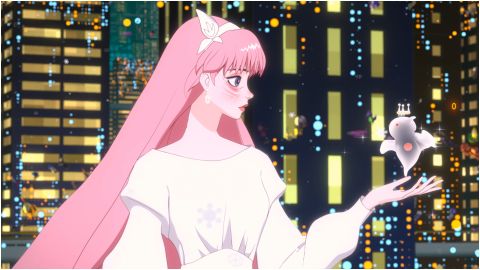Studio Chizu’s Mamoru Hosoda edged close to Studio Ghibli’s anime heights in 2018 with the Oscar-nominated Mirai, a homely and heartfelt twist on A Christmas Carol. Four years on, Hosoda closes the gap with his radical variant on another classic tale, Beauty And The Beast.
Between story, soundtrack, and sumptuous world-building, the Japanese writer/director’s immersive cyber-fable envelops you in color, feeling, and emo-pop epiphanies: even before the speaker-encrusted whales fly into view, Belle asserts itself as a feast for the heart and senses, mounted in dazzling shows of vision and ambition.
An enthralling opening sequence swiftly establishes the allure of ‘U’, an expansive virtual world where teenagers can generate self-idealized avatars based on "biometric information" – an irresistible invitation to the emotionally troubled or introverted. In real-world rural Japan, 17-year-old Suzu (Kaho Nakamura) grieves for the mother she lost as a child and struggles to connect with her saddened father.
In U, she becomes Belle, a glitter-bomb pop star whose voice is only marginally less silken than her hair. The appearance of a beastly Dragon (Takeru Satoh), complete with classical castle, shifts the balance in Belle’s U-niverse. As U-sers demand to know the self-protective and secretive monster’s true identity, Suzu becomes convinced that his fierce facade – "Leave or I’ll bite your head off," he roars - conceals gentler character traits. Something sweet? And almost kind? Or, as the livid bruises on his back suggest, something wounded?
Either way, Suzu elects to find out more about the boy behind the beast and the bruises. Without revealing too much, a tale of parallel traumas and their lingering after-effects gradually unfolds, part lifted with care from the fairytale source material and evolved from precedents set by Hosoda’s earlier work. In Wolf Children (2012), Hosoda drew on themes of family and separation; with Mirai, he explored a four-year-old boy’s jealous response to the arrival of a sister in his life, leading to tensions with his father.
As Suzu’s story develops in unexpected directions, Hosoda upholds the clear-sighted empathy of that earlier work with a warming beneficence. His tonal grip sure, Hosoda navigates awkward teenage crushes and liaisons with honest understanding and a careful comic touch, notably during a series of romantic misunderstandings at a train station. When characters blush before the subjects of their desires, they burn like overripe tomatoes with shame. Suzu’s friends provide endearing, droll counter-balance to our heroine’s struggles, from sardonic BFF and tech whizz Hiroka (Lilas Ikuta) to loveable nerd Shinjiro (Shota Sometani).
Along the way, Hosoda grounds these characters in lavish feats of animated world-building. For U’s infinite vistas, billboard-scale comments, and glittering code, Hosoda and Brit-based architecture lecturer-turned-production designer Eric Wong outstrip other animated visualizations of the internet.
Meanwhile, the real-world environs are realized with equally loving care. The soundtrack adds further succor for the senses, ranging from pop bangers and epic ballads to pulsing electronic soundscapes; among the contributors, Death Stranding composer Ludvig Forssell’s cues recall Trent Reznor and Atticus Ross’ celestial mood-pieces for Pixar’s Soul.
Between sensory hits, Hosoda feeds the brain with considered meditations on the internet’s power. While he recognizes the therapeutic benefits of online escapism, he also nods to its ambiguities. Suzu enjoys online success, then struggles with fame’s pendulum swing when comments-board critics weigh in.
The Dragon also draws followers and haters, from young admirers to online super-police the Justices, whose leader Justin threatens to use his all-powerful green ring to expose Belle and her beast. For Hosoda, these self-appointed virtual vigilantes – we’ve all met them - are no heroes: indeed, their assaults on the Dragon slyly echo the wolf-pack attacks from Disney’s Beauty And The Beast.
As for deeper struggles, Hosoda realizes that the ’net harbors at-best first-step solutions. The plot takes several deeper, darker turns at key moments, beginning with Suzu’s mother’s self-sacrificing rescue of a child from a river when Suzu was a kid. Struggling to comprehend why Mum would abandon her for a stranger’s offspring, Suzu’s inner torments cut deep into her psyche well into her teens, manifesting in tear-streaked outbursts.
Hosoda only stumbles with the darkness of another character’s personal life. Though the revelations unite and galvanize the characters on a shared mission, the real-world issues involved might be more than Hosoda can persuasively resolve. If the resolution is emotionally welcome, it’s also a little too tidy for comfort.
Even so, there’s no questioning the climax’s other big set-piece, a grand emotional reveal executed in crescendos of sound and vision. Leaping off boldly from self-realization subtexts, Hosoda gives a tale as old as time a ravishing new set of wings: timely, embracing, and potent.
Belle is in cinemas now. For more, check out our guide to the most exciting upcoming movies heading your way soon.


